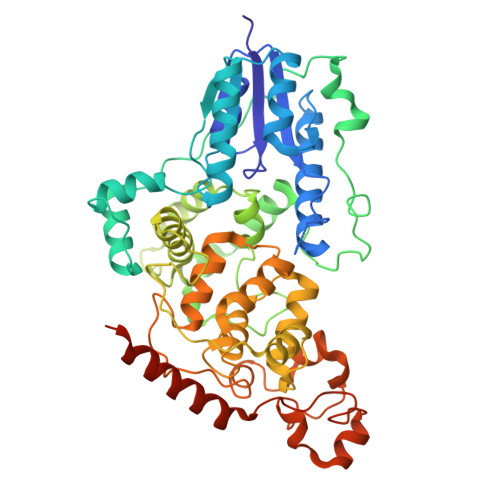Capturing structural intermediates in an animal-like cryptochrome photoreceptor by time-resolved crystallography.
Maestre-Reyna, M., Hosokawa, Y., Wang, P.H., Saft, M., Caramello, N., Engilberge, S., Franz-Badur, S., Gusti Ngurah Putu, E.P., Nakamura, M., Wu, W.J., Wu, H.Y., Lee, C.C., Huang, W.C., Huang, K.F., Chang, Y.K., Yang, C.H., Fong, M.I., Lin, W.T., Yang, K.C., Ban, Y., Imura, T., Kazuoka, A., Tanida, E., Owada, S., Joti, Y., Tanaka, R., Tanaka, T., Kang, J., Luo, F., Tono, K., Kiontke, S., Korf, L., Umena, Y., Tosha, T., Bessho, Y., Nango, E., Iwata, S., Royant, A., Tsai, M.D., Yamamoto, J., Essen, L.O.(2025) Sci Adv 11: eadu7247-eadu7247
- PubMed: 40378212
- DOI: https://doi.org/10.1126/sciadv.adu7247
- Primary Citation of Related Structures:
8Z1J, 8Z24, 8Z26, 8Z2D, 8Z3D, 8Z3G, 8Z3L, 8Z3X, 8Z41, 8Z44, 8Z45, 8Z4K, 8Z4M, 8Z4P, 8Z4U, 8Z6I, 8Z6J, 8Z6K, 8Z8F, 8Z8K, 8ZA8, 8ZLR - PubMed Abstract:
Animal-like cryptochromes are photoreceptors that control circadian rhythm and signaling in many eukaryotes. Transient photoreduction of the cryptochrome flavin chromophore initiated signaling via a poorly understood mechanism. By serial femtosecond crystallography (SFX), we show that the photoreduction mechanism of Chlamydomonas reinhardtii cryptochrome involves three loci [carboxyl-terminal region, a transient protonation pathway, and flavin adenine dinucleotide (FAD)-binding site] acting in unison to accomplish three effects: radical pair stabilization, protonation of FAD radical, and formation of the signaling state. Using 19 time-resolved SFX snapshots between 10 nanoseconds and 233 milliseconds, we found that light-driven FAD •- /tyrosyl-373 radical pair (RP) formation primes α22 unfolding. Electron transfer-dependent protonation of aspartate-321 by tyrosine-373 is the epicenter of unfolding by disrupting salt bridges between α22 and the photolyase homology region. Before helix unfolding, another pathway opens transiently for FAD •- protonation and RP stabilization. This link between RP formation and conformational changes provides a structural basis for signaling by animal-like cryptochromes.
Organizational Affiliation:
Department of Chemistry, National Taiwan University, 1Roosevelt Rd. Sec. 4, Taipei 106, Taiwan.


















